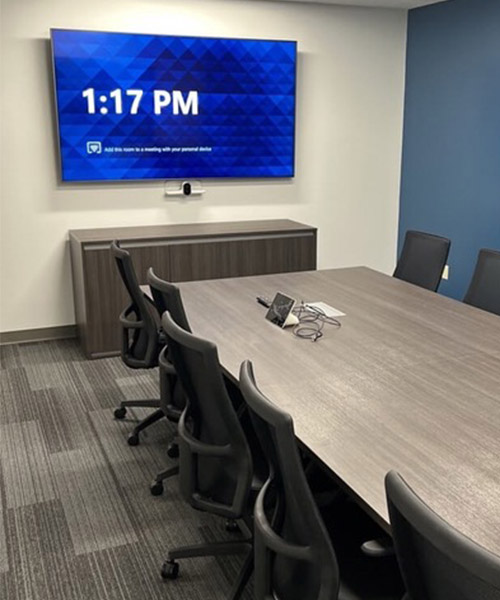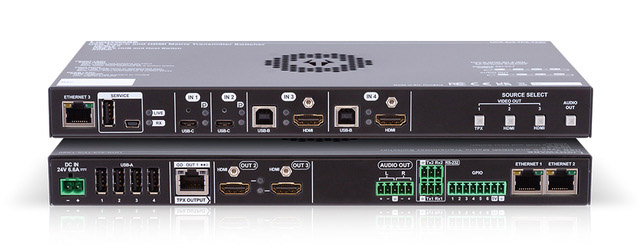USB-C Conference Room Connectivity
Here's how one wire is creating a dramatic shift in Pro AV.

CORRECTIONS AND LINKS
More than a decade ago, the first global standard for the HDMI specification was introduced. In general, the Pro AV industry resisted HDMI initially because there were many mysteries and restrictions surrounding this new technology. Nonetheless, as AV professionals overcame the early challenges, HDMI became the main connectivity standard—and since then, about 10 billion devices have been enabled with HDMI technology.
Today, we are at a similar turning point with USB-C.
In 1996, Universal Serial Bus, or USB, was introduced to standardize the connection of peripherals to personal computers with the goal of eliminating multiple connections, such as serial port, parallel port, and others to streamline connectivity with a singular, universal port. As newer generations of USB were introduced, bandwidth continued to increase. High-Speed USB 2.0 and SuperSpeed USB created viable options but included connection limitations and restrictions surrounding bandwidth and transmitting data.
Solving for BYOD

Today's meeting rooms and collaboration spaces are equipped with a wide range of devices including high-quality webcams, microphones, speakers, and dedicated room PCs to provide seamless meeting experiences. Beyond conducting meetings and video calls using these tools, users also expect to be able to use these peripherals easily and intuitively via their own personal devices, such as their laptops, tablets and mobile phones.
Most high-quality meeting room peripherals have already adopted USB-C, as have most laptops and mobile devices. The wide adoption of USB-C in today’s consumer technology is creating a dramatic shift in Pro AV applications and, because of the shift, USB-C will drastically change traditional meeting room connectivity. As USB-C becomes the primary connection point for these peripherals and devices, the need for a comprehensive meeting room solution to seamlessly integrate these components is more crucial than ever.
A daily selection of the top stories for AV integrators, resellers and consultants. Sign up below.
Previously, if meeting participants wanted to connect their own device to use the room’s USB peripherals, initiate video calls, or share their content on the room’s displays, they were met with multiple dongles and cables, creating confusion and unnecessary delays. Plus, they also had to keep an eye on their laptop’s battery level or carry their charger with them to every meeting. Things got even more complicated if another team member wanted to take over control—because "switching" between different BYOD hosts posed a difficult challenge on legacy systems.
[Strategies and Solutions for Corporate Campus Displays]
The key advantage of USB-C is that it allows the transmission of 4K video, audio, USB data, and Ethernet, as well as charging through a single connection, which eliminates the need for additional cables. Instead, USB‑C combines the functionality of four cables (USB, AV, Ethernet, and power) into one, effectively rendering legacy connections and designs obsolete.
USB C combines the functionality of four cables into one, effectively rendering legacy connections and designs obsolete.
This advantage translates into a wide range of benefits for both AV professionals and those using USB‑C-enabled meeting spaces. For installers and integrators, USB‑C means offering simpler rooms with more versatile functionality at a better price point. For businesses, it means lower investment while also creating future-ready collaboration spaces. And for end users, it delivers an enhanced meeting experience by simplifying how they connect to cameras and sound systems to share and present their content in the room.
Solutions like Lightware’s Taurus UCX product line are designed to simplify USB-C switching within collaborative environments, allowing users to walk into a room, connect their laptop or device, and use all available USB assets. Using a single cable to transfer all those signals also allows easy host-switching, enabling users to hand over control of the room to other team members, creating more freedom in BYOD operations.
Potential Complications
Despite USB technology having been around for a while, its adoption in professional environments is in its early stages and thus not free from challenges and installation complications. For example, integrators often run into problems when the last peripheral they plugged in caused the system to break, or video is not being sent from the source to the display, or even instances when connected USB peripherals don't show up on their computer.

Many of these issues can easily be avoided once we understand one of the core concepts of USB technology. USB devices connect to their host in a pyramid-like topology made of tiers, where the host (i.e., a BYOD laptop) is at the top at Tier 1 (sometimes taking up Tier 2 as well, also known as Root Hub). USB networks are limited by latency, and every USB peripheral, hub, or cable added to the chain takes up additional tiers and introduces latency.
Based on the average latency, the guideline is a maximum of seven tiers—exceeding this can lead to connection issues and other problems. But not every USB device is created equal. Depending on the class of the device, it can add different levels of latency, determining the number of tiers taken up in the USB pyramid.
Another set of installation complications is rooted in an often overlooked yet critical element of every USB‑C application, the USB‑C cable itself. If we agree that not every USB device is created equal, then this is particularly true about USB-C cables.
It can be challenging to determine if a particular USB-C cable is suitable for a Pro AV application simply by looking at it, given that the shape of the connector doesn’t reveal the features and the data speeds of the cable. Therefore, it is crucial that AV professionals choose the right, "full featured" cable, which allows them to bring the most out of USB-C technology and helps avoid any operational issues, such as lack of charging or insufficient video transmission.
Roger Takacs is Lightware's executive VP of sales for the Americas Region.

